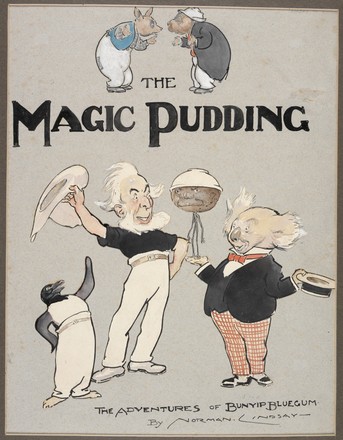The Magic Pudding
1918
Pencil, ink and watercolour on paper in 8 bound volumes
Bequest of Sir William Dixson, 1952
DL PXX 49-56
This children’s classic tells the adventures of Bunyip Bluegum the koala, his friends, and Albert, ‘a quarrelsome, endlessly renewable pudding, who can turn himself into any type of pudding your tastebuds desire’. Lindsay’s distinctive drawings and mix of comic verse and satire brilliantly capture the personalities of his characters, including wombats, koalas, bandicoots, crows, kookaburras and other animals of the Australian bush.
First published in 1918, The Magic Pudding has never been out of print. The story has been translated into several different languages and adapted for puppet theatre, an audio book and animated film.
A National Metaphor?
In
2007 writer and critic David Dale began searching for a ‘National Metaphor’ for
Australia. He chose the Magic Pudding from Norman Lindsay’s popular book:
‘My favourite is a metaphor created in the year 1918 by the artist
and writer Norman Lindsay, which became so widely used that it ended up with
its own entry in the Macquarie Dictionary. The Magic Pudding (defined as an
"endlessly renewable resource") operated on two rules: 1. "The
more you eats, the more you gets"; and 2. “If you want to change his
flavour, just whistle three times and turn the basin round”.’*
Footnotes
http://blogs.smh.com.au/sit/archives/2007/02/who_we_are_draft.html
Owners and Thieves
Norman Lindsay said the world is divided into Puddin' Owners and
Puddin' Thieves. Former prime minister Paul Keating used to call his successor
John Howard a Puddin' Thief, and accused the Liberal Party of repeatedly using
Telstra as a Magic Pudding, ‘from which they could cut a slice to pay for their
election commitments’.* More recently environmentalists have argued that we
treat this continent as if it were a Magic Pudding, and thus are exhausting its
resources.
Footnotes
http://www.abc.net.au/7.30/content/2004/s1163288.htm
An Artist Among Many
Norman Lindsay came from a family of
ten children, five of whom became artists: his eldest brother Percy painted
landscapes; Lionel was an illustrator, photographer and noted printmaker; his
sister Ruby drew under the name of Ruby Lind; and younger brother Daryl was a
painter, who served for a time as director of the National Gallery of Victoria.
Norman was as well known for his
technical mastery and wild imagination as he was for the controversy
surrounding his drawings of Australia's changing social attitudes for the Bulletin newspaper, and his liberal
attitude towards sex in his life and work.



 Back to list
Back to list